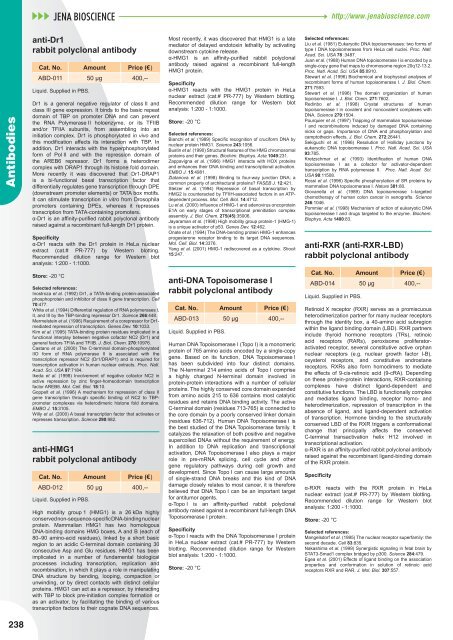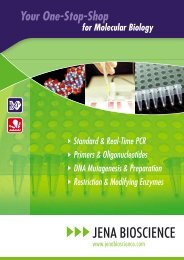Nucleotide Analogs - Jena Bioscience
Nucleotide Analogs - Jena Bioscience
Nucleotide Analogs - Jena Bioscience
You also want an ePaper? Increase the reach of your titles
YUMPU automatically turns print PDFs into web optimized ePapers that Google loves.
Antibodies<br />
238<br />
anti-Dr1<br />
rabbit polyclonal antibody<br />
Cat. No. Amount Price (€)<br />
ABD-011 50 µg 400,--<br />
Liquid. Supplied in PBS.<br />
Dr1 is a general negative regulator of class II and<br />
class III gene expression. It binds to the basic repeat<br />
domain of TBP on promoter DNA and can prevent<br />
the RNA Polymerase II holoenzyme, or its TFIIB<br />
and/or TFIIA subunits, from assembling into an<br />
initiation complex. Dr1 is phosphorylated in vivo and<br />
this modifi cation affects its interaction with TBP. In<br />
addition, Dr1 interacts with the hyperphosphorylated<br />
form of Pol II and with the repression domain of<br />
the AREB6 repressor. Dr1 forms a heterodimer<br />
complex with DRAP1 through its histone fold domain.<br />
More recently it was discovered that Dr1-DRAP1<br />
is a bi-functional basal transcription factor that<br />
differentially regulates gene transcription through DPE<br />
(downstream promoter elements) or TATA box motifs.<br />
It can stimulate transcription in vitro from Drosophila<br />
promoters containing DPEs, whereas it represses<br />
transcription from TATA-containing promoters.<br />
α-Dr1 is an affi nity-purifi ed rabbit polyclonal antibody<br />
raised against a recombinant full-length Dr1 protein.<br />
Specifi city<br />
α-Dr1 reacts with the Dr1 protein in HeLa nuclear<br />
extract (cat.# PR-777) by Western blotting.<br />
Recommended dilution range for Western blot<br />
analysis: 1:200 - 1:1000.<br />
Store: -20 °C<br />
Selected references:<br />
Inostroza et al. (1992) Dr1, a TATA-binding protein-associated<br />
phosphoprotein and inhibitor of class II gene transcription. Cell<br />
70:477.<br />
White et al. (1994) Differential regulation of RNA polymerases I,<br />
II, and III by the TBP-binding repressor Dr1. Science 266:448.<br />
Mermelstein et al. (1996) Requirement of a corepressor for Dr1mediated<br />
repression of transcription. Genes Dev. 10:1033.<br />
Kim et al. (1995) TATA-binding protein residues implicated in a<br />
functional interplay between negative cofactor NC2 (Dr1) and<br />
general factors TFIIA and TFIIB. J. Biol. Chem. 270:10976.<br />
Castano et al. (2000) The C-terminal domain-phosphorylated<br />
IIO form of RNA polymerase II is associated with the<br />
transcription repressor NC2 (Dr1/DRAP1) and is required for<br />
transcription activation in human nuclear extracts. Proc. Natl.<br />
Acad. Sci. USA 97:7184.<br />
Ikeda et al. (1998) Involvement of negative cofactor NC2 in<br />
active repression by zinc fi nger-homeodomain transcription<br />
factor AREB6. Mol. Cell. Biol. 18:10.<br />
Goppelt et al. (1996) A mechanism for repression of class II<br />
gene transcription through specifi c binding of NC2 to TBPpromoter<br />
complexes via heterodimeric histone fold domains.<br />
EMBO J. 15:3105.<br />
Willy et al. (2000) A basal transcription factor that activates or<br />
represses transcription. Science 290:982.<br />
anti-HMG1<br />
rabbit polyclonal antibody<br />
Cat. No. Amount Price (€)<br />
ABD-012 50 µg 400,--<br />
Liquid. Supplied in PBS.<br />
High mobility group 1 (HMG1) is a 26 kDa highly<br />
conserved non-sequence-specifi c DNA-binding nuclear<br />
protein. Mammalian HMG1 has two homologous<br />
DNA-binding domains HMG boxes, A and B (each of<br />
80–90 amino-acid residues), linked by a short basic<br />
region to an acidic C-terminal domain containing 30<br />
consecutive Asp and Glu residues. HMG1 has been<br />
implicated in a number of fundamental biological<br />
processes including transcription, replication and<br />
recombination, in which it plays a role in manipulating<br />
DNA structure by bending, looping, compaction or<br />
unwinding, or by direct contacts with distinct cellular<br />
proteins. HMG1 can act as a repressor, by interacting<br />
with TBP to block pre-initiation complex formation or<br />
as an activator, by facilitating the binding of various<br />
transcription factors to their cognate DNA sequences.<br />
Most recently, it was discovered that HMG1 is a late<br />
mediator of delayed endotoxin lethality by activating<br />
downstream cytokine release.<br />
α-HMG1 is an affi nity-purifi ed rabbit polyclonal<br />
antibody raised against a recombinant full-length<br />
HMG1 protein.<br />
Specifi city<br />
α-HMG1 reacts with the HMG1 protein in HeLa<br />
nuclear extract (cat.# PR-777) by Western blotting.<br />
Recommended dilution range for Western blot<br />
analysis: 1:200 - 1:1000.<br />
Store: -20 °C<br />
Selected references:<br />
Bianchi et al. (1989) Specifi c recognition of cruciform DNA by<br />
nuclear protein HMG1. Science 243:1056.<br />
Bustin et al. (1990) Structural features of the HMG chromosomal<br />
proteins and their genes. Biochim. Biophys. Acta 1049:231.<br />
Zappavigna et al. (1996) HMG1 interacts with HOX proteins<br />
and enhances their DNA binding and transcriptional activation.<br />
EMBO J. 15:4981.<br />
Zlatanova et al. (1998) Binding to four-way junction DNA: a<br />
common property of architectural proteins? FASEB J. 12:421.<br />
Stelzer et al. (1994) Repression of basal transcription by<br />
HMG2 is counteracted by TFIIH-associated factors in an ATPdependent<br />
process. Mol. Cell. Biol. 14:4712.<br />
Lu et al. (2000) Infl uence of HMG-1 and adenovirus oncoprotein<br />
E1A on early stages of transcriptional preinitiation complex<br />
assembly. J. Biol. Chem. 275(45):35006.<br />
Jayaraman et al. (1998) High mobility group protein-1 (HMG-1)<br />
is a unique activator of p53. Genes Dev. 12:462.<br />
Onate et al. (1994) The DNA-bending protein HMG-1 enhances<br />
progesterone receptor binding to its target DNA sequences.<br />
Mol. Cell. Biol. 14:3376.<br />
Yang et al. (2001) HMG-1 rediscovered as a cytokine. Shock<br />
15:247.<br />
anti-DNA Topoisomerase I<br />
rabbit polyclonal antibody<br />
Cat. No. Amount Price (€)<br />
ABD-013 50 µg 400,--<br />
Liquid. Supplied in PBS.<br />
Human DNA Topoisomerase I (Topo I) is a monomeric<br />
protein of 765 amino acids encoded by a single-copy<br />
gene. Based on its function, DNA Topoisomerase I<br />
has been subdivided into four distinct domains.<br />
The N-terminal 214 amino acids of Topo I comprise<br />
a highly charged N-terminal domain involved in<br />
protein-protein interactions with a number of cellular<br />
proteins. The highly conserved core domain expanded<br />
from amino acids 215 to 636 contains most catalytic<br />
residues and retains DNA binding activity. The active<br />
C-terminal domain (residues 713-765) is connected to<br />
the core domain by a poorly conserved linker domain<br />
(residues 636-712). Human DNA Topoisomerase I is<br />
the best studied of the DNA Topoisomerase family. It<br />
catalyzes the relaxation of both positive and negative<br />
supercoiled DNAs without the requirement of energy.<br />
In addition to DNA replication and transcriptional<br />
activation, DNA Topoisomerase I also plays a major<br />
role in pre-mRNA splicing, cell cycle and other<br />
gene regulatory pathways during cell growth and<br />
development. Since Topo I can cause large amounts<br />
of single-strand DNA breaks and this kind of DNA<br />
damage closely relates to most cancer, it is therefore<br />
believed that DNA Topo I can be an important target<br />
for antitumor agents.<br />
α-Topo I is an affi nity-purifi ed rabbit polyclonal<br />
antibody raised against a recombinant full-length DNA<br />
Topoisomerase I protein.<br />
Specifi city<br />
α-Topo I reacts with the DNA Topoisomerase I protein<br />
in HeLa nuclear extract (cat.# PR-777) by Western<br />
blotting. Recommended dilution range for Western<br />
blot analysis: 1:200 - 1:1000.<br />
Store: -20 °C<br />
http://www.jenabioscience.com<br />
Selected references:<br />
Liu et al. (1981) Eukaryotic DNA topoisomerases: two forms of<br />
type I DNA topoisomerases from HeLa cell nuclei. Proc. Natl.<br />
Acad. Sci. USA 78 :3487.<br />
Juan et al. (1988) Human DNA topoisomerase I is encoded by a<br />
single-copy gene that maps to chromosome region 20q12-13.2.<br />
Proc. Natl. Acad. Sci. USA 85:8910.<br />
Stewart et al. (1996) Biochemical and biophysical analyses of<br />
recombinant forms of human topoisomerase I. J. Biol. Chem.<br />
271:7593.<br />
Stewart et al. (1996) The domain organization of human<br />
topoisomerase I. J. Biol. Chem. 271:7602.<br />
Redinbo et al. (1998) Crystal structures of human<br />
topoisomerase I in covalent and noncovalent complexes with<br />
DNA. Science 279:1504.<br />
Pourquier et al. (1997) Trapping of mammalian topoisomerase<br />
I and recombinations induced by damaged DNA containing<br />
nicks or gaps. Importance of DNA end phosphorylation and<br />
camptothecin effects. J. Biol. Chem. 272:26441.<br />
Sekiguchi et al. (1996) Resolution of Holliday junctions by<br />
eukaryotic DNA topoisomerase I. Proc. Natl. Acad. Sci. USA<br />
93:785.<br />
Kretzschmar et al. (1993) Identifi cation of human DNA<br />
topoisomerase I as a cofactor for activator-dependent<br />
transcription by RNA polymerase II. Proc. Natl. Acad. Sci.<br />
USA 90:11508.<br />
Rossi et al. (1996) Specifi c phosphorylation of SR proteins by<br />
mammalian DNA topoisomerase I. Nature 381:80.<br />
Giovanella et al. (1989) DNA topoisomerase I--targeted<br />
chemotherapy of human colon cancer in xenografts. Science<br />
246:1046.<br />
Pommier et al. (1998) Mechanism of action of eukaryotic DNA<br />
topoisomerase I and drugs targeted to the enzyme. Biochem.<br />
Biophys. Acta 1400:83.<br />
anti-RXR (anti-RXR-LBD)<br />
rabbit polyclonal antibody<br />
Cat. No. Amount Price (€)<br />
ABD-014 50 µg 400,--<br />
Liquid. Supplied in PBS.<br />
Retinoid X receptor (RXR) serves as a promiscuous<br />
heterodimerization partner for many nuclear receptors<br />
through the identity box, a 40-amino acid subregion<br />
within the ligand binding domain (LBD). RXR partners<br />
include thyroid hormone receptors (TRs), retinoic<br />
acid receptors (RARs), peroxisome proliferatoractivated<br />
receptor, several constitutive active orphan<br />
nuclear receptors (e.g. nuclear growth factor I-B),<br />
oxysterol receptors, and constitutive androstane<br />
receptors. RXRs also form homodimers to mediate<br />
the effects of 9-cis-retinoic acid (9-cRA). Depending<br />
on these protein-protein interactions, RXR-containing<br />
complexes have distinct ligand-dependent and<br />
constitutive functions. The LBD is functionally complex<br />
and mediates ligand binding, receptor homo- and<br />
heterodimerization, repression of transcription in the<br />
absence of ligand, and ligand-dependent activation<br />
of transcription. Hormone binding to the structurally<br />
conserved LBD of the RXR triggers a conformational<br />
change that principally affects the conserved<br />
C-terminal transactivation helix H12 involved in<br />
transcriptional activation.<br />
α-RXR is an affi nity-purifi ed rabbit polyclonal antibody<br />
raised against the recombinant ligand-binding domain<br />
of the RXR protein.<br />
Specifi city<br />
α-RXR reacts with the RXR protein in HeLa<br />
nuclear extract (cat.# PR-777) by Western blotting.<br />
Recommended dilution range for Western blot<br />
analysis: 1:200 - 1:1000.<br />
Store: -20 °C<br />
Selected references:<br />
Mangelsdorf et al. (1995) The nuclear receptor superfamily: the<br />
second decade. Cell 83:835.<br />
Nakashima et al. (1999) Synergistic signaling in fetal brain by<br />
STAT3-Smad1 complex bridged by p300. Science 284:479.<br />
Egea et al. (2001) Effects of ligand binding on the association<br />
properties and conformation in solution of retinoic acid<br />
receptors RXR and RAR. J. Mol. Biol. 307:557.



